Concentrated Solar Power in Australia
Added on 2023-03-23
24 Pages6788 Words96 Views
Concentrated Solar Power (CSP) 1
CONCENTRATED SOLAR POWER IN AUSTRALIA
By Name
Course
Instructor
Institution
Location
Date
CONCENTRATED SOLAR POWER IN AUSTRALIA
By Name
Course
Instructor
Institution
Location
Date
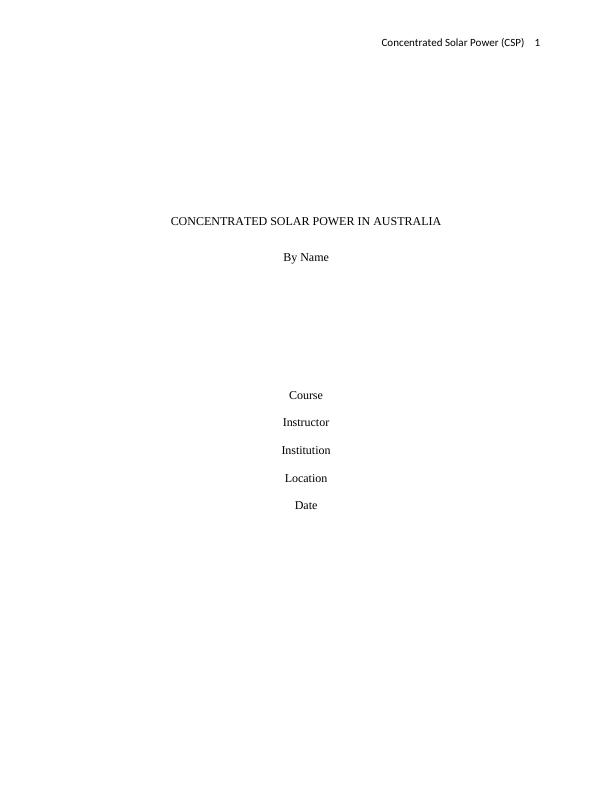
Concentrated Solar Power (CSP) 2
Table of Contents
INTRODUCTION...........................................................................................................................................3
ENERGY IN AUSTRALIA................................................................................................................................3
SOLAR ENERGY............................................................................................................................................5
CONCENTRATED SOLAR POWER TECHNOLOGY...........................................................................................6
Parabolic Trough......................................................................................................................................7
Solar Power Tower..................................................................................................................................8
Enclosed Trough......................................................................................................................................9
Fresnel Reflectors....................................................................................................................................9
Dish Stirling............................................................................................................................................10
IMPACTS OF CSP........................................................................................................................................11
Reduced Cost of Conventional Fuels.....................................................................................................11
Reduced Carbon Emission.....................................................................................................................11
Supplement Other Energy Sources........................................................................................................12
Employment..........................................................................................................................................12
Impacts of Wildlife.................................................................................................................................13
Economic Impact...................................................................................................................................13
TECHNICAL DEVELOPMENTS.....................................................................................................................14
Future Technology.................................................................................................................................15
Larger CSP Plants...................................................................................................................................16
Suitable Sites.........................................................................................................................................16
BARRIERS AND OPPORTUNITIES................................................................................................................17
Water Availability..................................................................................................................................17
Visual Effect...........................................................................................................................................18
Energy and Material Use.......................................................................................................................18
Capital Cost Evaluation..........................................................................................................................19
PERSONAL OPINION..................................................................................................................................20
CONCLUSION.............................................................................................................................................20
BIBLIOGRAPHY...........................................................................................................................................22
Table of Contents
INTRODUCTION...........................................................................................................................................3
ENERGY IN AUSTRALIA................................................................................................................................3
SOLAR ENERGY............................................................................................................................................5
CONCENTRATED SOLAR POWER TECHNOLOGY...........................................................................................6
Parabolic Trough......................................................................................................................................7
Solar Power Tower..................................................................................................................................8
Enclosed Trough......................................................................................................................................9
Fresnel Reflectors....................................................................................................................................9
Dish Stirling............................................................................................................................................10
IMPACTS OF CSP........................................................................................................................................11
Reduced Cost of Conventional Fuels.....................................................................................................11
Reduced Carbon Emission.....................................................................................................................11
Supplement Other Energy Sources........................................................................................................12
Employment..........................................................................................................................................12
Impacts of Wildlife.................................................................................................................................13
Economic Impact...................................................................................................................................13
TECHNICAL DEVELOPMENTS.....................................................................................................................14
Future Technology.................................................................................................................................15
Larger CSP Plants...................................................................................................................................16
Suitable Sites.........................................................................................................................................16
BARRIERS AND OPPORTUNITIES................................................................................................................17
Water Availability..................................................................................................................................17
Visual Effect...........................................................................................................................................18
Energy and Material Use.......................................................................................................................18
Capital Cost Evaluation..........................................................................................................................19
PERSONAL OPINION..................................................................................................................................20
CONCLUSION.............................................................................................................................................20
BIBLIOGRAPHY...........................................................................................................................................22
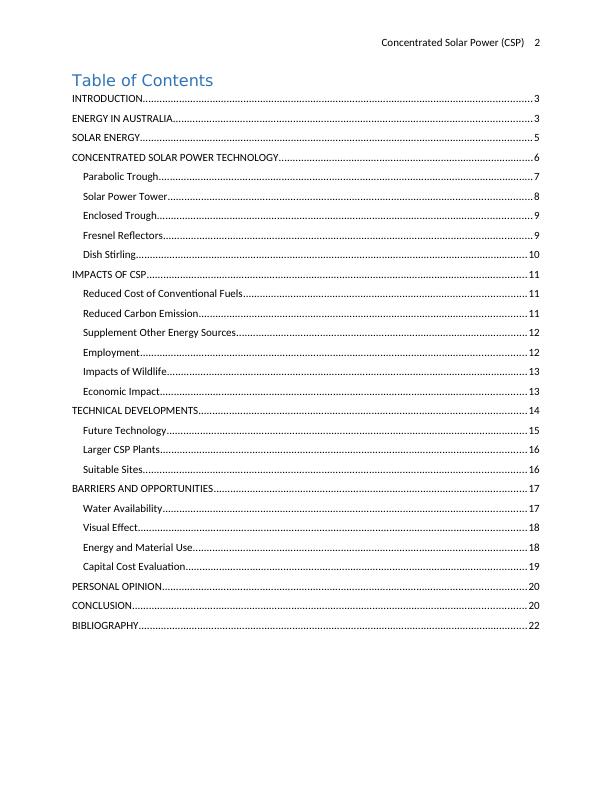
Concentrated Solar Power (CSP) 3
INTRODUCTION
This report on the Concentrated Solar Power in Australia investigates the current state of the
technology, the impact of the CSP energy system and other fuels, technical development,
currently and into the future, opportunities and barriers, and individual view on the technology.
CSP is a method of electrical energy generation fueled by free, clean, and endless heat from the
sun. The Concentrated solar power, commonly abbreviated at CSP and also referred to as
concentrated solar thermal or concentrating solar power is a solar power generating system by
the use of lenses or mirrors to concentrate solar thermal energy or huge area of sunlight onto a
small area (Chukwuka & Agbenyo, 2014). This type of solar technology needs direct and direct
and strong solar radiation and is basically used as a centralized, large source of power for
utilities.
Electrical energy is produced when the concentrated light is converted into heat, which operates
steam turbines and heat engine coupled to a generator of electrical power. The concentrated
thermal energy can also be used in the production of electricity or stored and later used when it is
needed during the night hours. Currently, Australia has approximately 44MW of Concentrated
Solar Power under operation (Kogan Creek Solar Boost) and 8.5MW installed in Lake
Cargelligo and Liddell. In most instances, the Concentrated Solar Power technologies cannot
compete with solar PV panels on price due to the high rate of growth in the past years because of
much smaller cost of operation and falling prices (Beath, 2012).
ENERGY IN AUSTRALIA
Australia is known for the electricity generation and energy for both export and consumption and
until recently, Australia uses energy from sources like natural gas and coal. However, due to the
increasing effects of human-induced climate change and global warming, there has been a shift
INTRODUCTION
This report on the Concentrated Solar Power in Australia investigates the current state of the
technology, the impact of the CSP energy system and other fuels, technical development,
currently and into the future, opportunities and barriers, and individual view on the technology.
CSP is a method of electrical energy generation fueled by free, clean, and endless heat from the
sun. The Concentrated solar power, commonly abbreviated at CSP and also referred to as
concentrated solar thermal or concentrating solar power is a solar power generating system by
the use of lenses or mirrors to concentrate solar thermal energy or huge area of sunlight onto a
small area (Chukwuka & Agbenyo, 2014). This type of solar technology needs direct and direct
and strong solar radiation and is basically used as a centralized, large source of power for
utilities.
Electrical energy is produced when the concentrated light is converted into heat, which operates
steam turbines and heat engine coupled to a generator of electrical power. The concentrated
thermal energy can also be used in the production of electricity or stored and later used when it is
needed during the night hours. Currently, Australia has approximately 44MW of Concentrated
Solar Power under operation (Kogan Creek Solar Boost) and 8.5MW installed in Lake
Cargelligo and Liddell. In most instances, the Concentrated Solar Power technologies cannot
compete with solar PV panels on price due to the high rate of growth in the past years because of
much smaller cost of operation and falling prices (Beath, 2012).
ENERGY IN AUSTRALIA
Australia is known for the electricity generation and energy for both export and consumption and
until recently, Australia uses energy from sources like natural gas and coal. However, due to the
increasing effects of human-induced climate change and global warming, there has been a shift
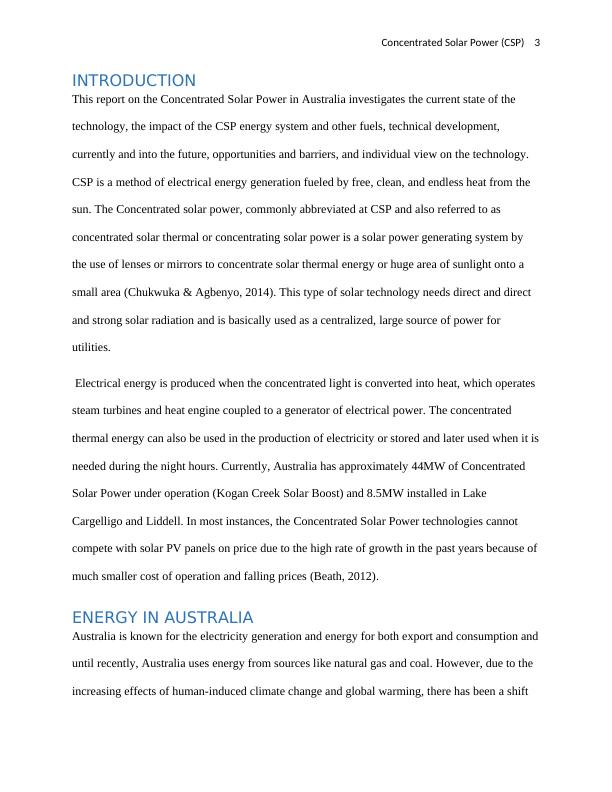
Concentrated Solar Power (CSP) 4
towards renewable energy like solar and wind power (Sajid, 2014). The major fuels used in
Australia include natural gas from gas basins in Brawse basis in West Australia, cola from New
South Wales, and oil in open cut. Australian renewable energy is currently being considered to
quantify and expand the usage of renewable energy sources in electricity production, thermal
energy, and fuel in transport (Blakers & Stocks, 2017). The development of a renewable energy
source in Australia has been promoted by government policies in response to concerns
concerning climate change, economic stimulus, energy independence. The implementation of
these energy policies in 2010 promoted the establishment of large-scale renewable energy to
41,000Wh renewable energy generation in 2010.
Energies consumed by human beings can either be categorized as nonrenewable or renewable
energy sources. Sources of renewable energy include wind energy, biomass energy, geothermal
energy, and solar energy. The total percentage of renewable energy consumption in Australia
stands at 5.9 % with 19.2% representing hydropower, 3.6% representing biofuels, 10.7%
representing wind energy, 53% representing biomass, 3.8% representing solar hot water, 5.1%
representing solar PV, as shown in the figure below. (Blakers & Stocks, 2017)
Figure 1: Energy usage in Australia (Davy & Troccoli, 2012)
towards renewable energy like solar and wind power (Sajid, 2014). The major fuels used in
Australia include natural gas from gas basins in Brawse basis in West Australia, cola from New
South Wales, and oil in open cut. Australian renewable energy is currently being considered to
quantify and expand the usage of renewable energy sources in electricity production, thermal
energy, and fuel in transport (Blakers & Stocks, 2017). The development of a renewable energy
source in Australia has been promoted by government policies in response to concerns
concerning climate change, economic stimulus, energy independence. The implementation of
these energy policies in 2010 promoted the establishment of large-scale renewable energy to
41,000Wh renewable energy generation in 2010.
Energies consumed by human beings can either be categorized as nonrenewable or renewable
energy sources. Sources of renewable energy include wind energy, biomass energy, geothermal
energy, and solar energy. The total percentage of renewable energy consumption in Australia
stands at 5.9 % with 19.2% representing hydropower, 3.6% representing biofuels, 10.7%
representing wind energy, 53% representing biomass, 3.8% representing solar hot water, 5.1%
representing solar PV, as shown in the figure below. (Blakers & Stocks, 2017)
Figure 1: Energy usage in Australia (Davy & Troccoli, 2012)
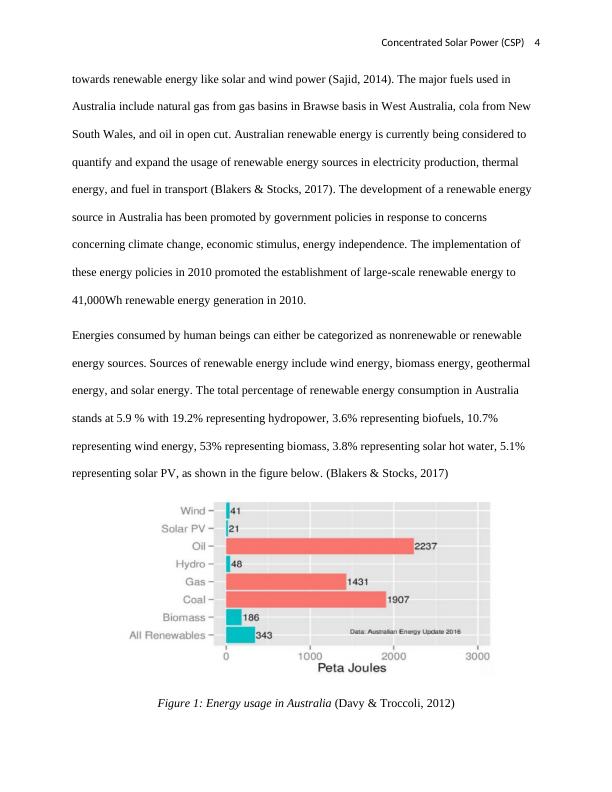
Concentrated Solar Power (CSP) 5
There are a total of 15 wind energy projects with a total generation capacity of 2112MW with are
either in operation or under construction. A total of 1880MW installed capacity will be attained
after the conclusion of all the wind projects in Australia. There are various companies that are
currently exploiting 141 regions and are anticipated to invest in the sector of geothermal energy
in Australia (Merched & Hiep, 2015).
SOLAR ENERGY
A system of solar energy operates by the conversion process of solar energy into electrical power
through direct solar photovoltaics or indirect concentrated solar power, or even a combination of
the two techniques. The two major technologies of solar energy that are presently being used in
Australia include photovoltaic solar system and concentrated solar power system (Kalda, et al.,
2013). Solar energy is the radiation heat from the sun which can be converted by the application
of technologies like solar heating, artificial photosynthesis, photovoltaics, molten salt power
plants, solar thermal energy, and solar architecture. Solar energy is an important source of
renewable energy and the technologies involved can broadly be categorized depending on
conversion, capture and distribution as either passive or active solar.
The passive solar method involves the orientation of a structure to the sun, selecting a material
with the properties of light dispersion, and then designing spaces that permit free circulation of
air. The active solar method entails the use of concentrating solar power, solar water heating, and
a photovoltaic system to convert the sunlight energy.
A solar photovoltaic system contains photovoltaic cells that are involved in the light energy
conversion from the sun into electrical power through the application of the photovoltaic effect.
The solar photovoltaic cells were initially used as sources of electrical energy for both small-
sized and medium-sized applications like remote homes operated by an off-grid photovoltaic
There are a total of 15 wind energy projects with a total generation capacity of 2112MW with are
either in operation or under construction. A total of 1880MW installed capacity will be attained
after the conclusion of all the wind projects in Australia. There are various companies that are
currently exploiting 141 regions and are anticipated to invest in the sector of geothermal energy
in Australia (Merched & Hiep, 2015).
SOLAR ENERGY
A system of solar energy operates by the conversion process of solar energy into electrical power
through direct solar photovoltaics or indirect concentrated solar power, or even a combination of
the two techniques. The two major technologies of solar energy that are presently being used in
Australia include photovoltaic solar system and concentrated solar power system (Kalda, et al.,
2013). Solar energy is the radiation heat from the sun which can be converted by the application
of technologies like solar heating, artificial photosynthesis, photovoltaics, molten salt power
plants, solar thermal energy, and solar architecture. Solar energy is an important source of
renewable energy and the technologies involved can broadly be categorized depending on
conversion, capture and distribution as either passive or active solar.
The passive solar method involves the orientation of a structure to the sun, selecting a material
with the properties of light dispersion, and then designing spaces that permit free circulation of
air. The active solar method entails the use of concentrating solar power, solar water heating, and
a photovoltaic system to convert the sunlight energy.
A solar photovoltaic system contains photovoltaic cells that are involved in the light energy
conversion from the sun into electrical power through the application of the photovoltaic effect.
The solar photovoltaic cells were initially used as sources of electrical energy for both small-
sized and medium-sized applications like remote homes operated by an off-grid photovoltaic
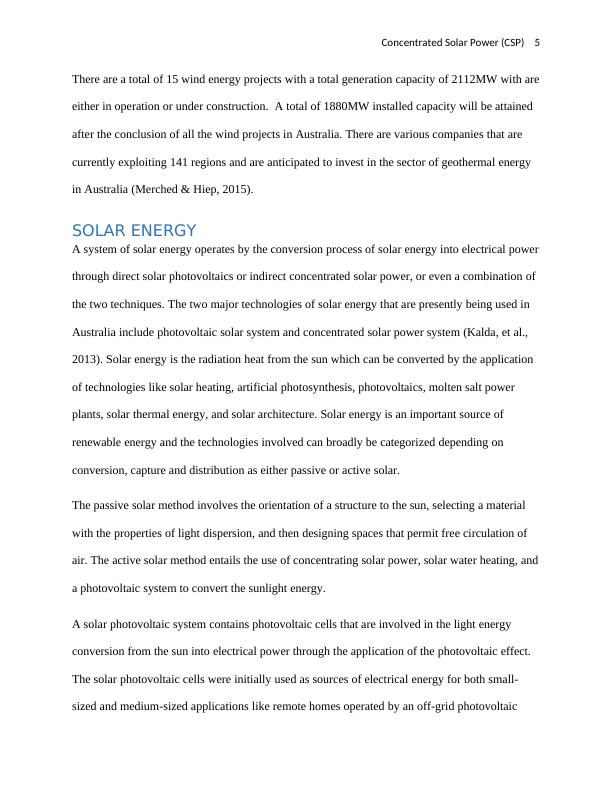
Concentrated Solar Power (CSP) 6
system (Ching, 2011). The concentrating solar thermal system generally applies the lenses or
mirrors and tracking system to concentrate light from the sun and then use the concentrated solar
energy in the electricity generation from the traditional steam engine (Guang & Wang, 2013). A
hybrid system combines both the concentrating solar power system and the PV cells with other
power generation forms like diesel, wind and biogas. This combination has the capability of
minimizing the non-renewable fuel consumption and variation trend of solar energy as a demand
function.
CONCENTRATED SOLAR POWER TECHNOLOGY
The CSP is a technology for solar power generation and uses mirrors or lenses to concentrate the
energy from solar onto a small region. Electrical energy is generated when the light concentrated
is converted into heat energy which powers the heat engine coupled to a generator of electrical
power or thermochemical reaction (Sakellariou, et al., 2015). The thermal energy concentrated
can be kept and then and then used in the electrical energy generation when needed during night
hours. The two commercial concentrated solar power technologies that are currently being used
in Australia include power towers and parabolic troughs. The other concentrated solar power
technologies that have also been implemented for solar energy generation include compact liners
Fresnel reflector and dish engine.
The Australian markets have been conquered by parabolic trough plants at a percentage of 90%
of the overall number of concentrated solar panels technology in the country. In many cases, the
concentrated solar power technologies cannot compete with solar PV panels due to the drastic
developments that have been done by the solar PV system to reduce their operation cost and
reduced price. The concentrated solar panels normally need a large supply of direct solar
radiation which in many cases is prevented by cloud cover or the solar panels being opposite
system (Ching, 2011). The concentrating solar thermal system generally applies the lenses or
mirrors and tracking system to concentrate light from the sun and then use the concentrated solar
energy in the electricity generation from the traditional steam engine (Guang & Wang, 2013). A
hybrid system combines both the concentrating solar power system and the PV cells with other
power generation forms like diesel, wind and biogas. This combination has the capability of
minimizing the non-renewable fuel consumption and variation trend of solar energy as a demand
function.
CONCENTRATED SOLAR POWER TECHNOLOGY
The CSP is a technology for solar power generation and uses mirrors or lenses to concentrate the
energy from solar onto a small region. Electrical energy is generated when the light concentrated
is converted into heat energy which powers the heat engine coupled to a generator of electrical
power or thermochemical reaction (Sakellariou, et al., 2015). The thermal energy concentrated
can be kept and then and then used in the electrical energy generation when needed during night
hours. The two commercial concentrated solar power technologies that are currently being used
in Australia include power towers and parabolic troughs. The other concentrated solar power
technologies that have also been implemented for solar energy generation include compact liners
Fresnel reflector and dish engine.
The Australian markets have been conquered by parabolic trough plants at a percentage of 90%
of the overall number of concentrated solar panels technology in the country. In many cases, the
concentrated solar power technologies cannot compete with solar PV panels due to the drastic
developments that have been done by the solar PV system to reduce their operation cost and
reduced price. The concentrated solar panels normally need a large supply of direct solar
radiation which in many cases is prevented by cloud cover or the solar panels being opposite
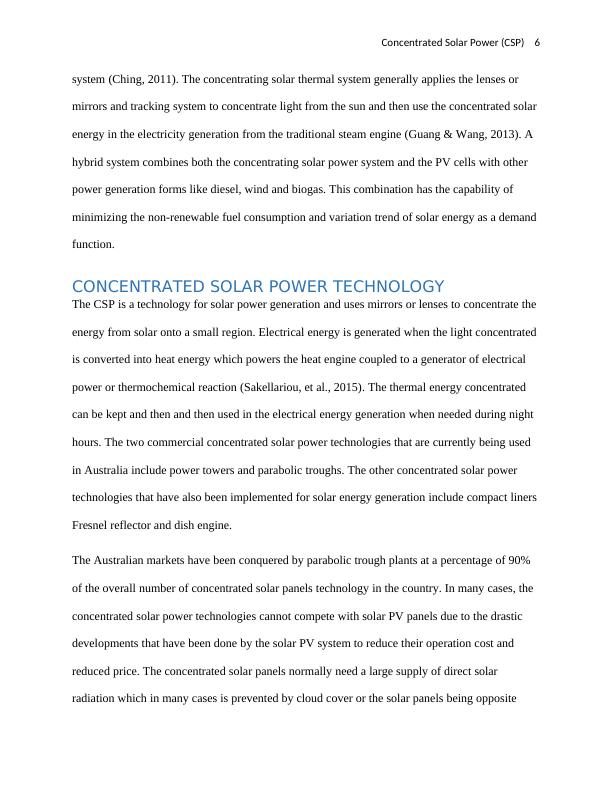
End of preview
Want to access all the pages? Upload your documents or become a member.
Related Documents
Concentrated Solar Power: Technologies, Impacts, Technical Developments, Barriers and Opportunitieslg...
|19
|4785
|126
Solar Energy: Advantages, Disadvantages and Applicationslg...
|6
|958
|146
Concentrating Solar Power Technologylg...
|22
|5917
|255
Feasibility of Solar Energy Supplying the Electrical Energy Needs for Australialg...
|45
|13744
|395
Concentrated Solar Power in Africalg...
|19
|4581
|65
Solar Thermal Power Station: Pre-Feasibility Studylg...
|16
|3029
|413
